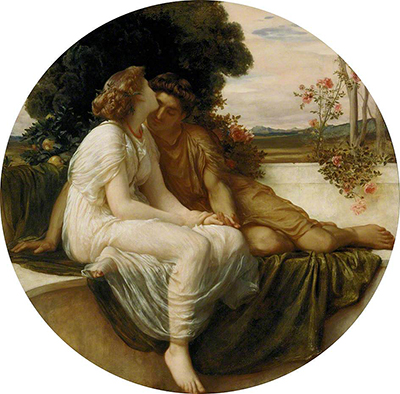Frederic Leighton was known for the an inclusion of classical and religious themes within many of his works. Created sometime around 1868, Acme and Septimius is a prime example of this observation.
While also respected as a sculptor, Leighton had a significant impact upon Neoclassicism; some referring to works such as Acme and Septimius as "hyper-real" Neoclassicism. This only stands to reason when we take into account the fact that this painting already exhibits many of the Naturalistic traits espoused by the Pre-Raphaelites of the time period. This work represents an interesting combination of unique ideas and artistic approaches which deserve a closer look.
Bordering Between Neoclassicism and Academic Historical Paintings
Leighton was known for his nearly obsessive attention to detail; a trait which can be seen in his other works such as Flaming June and After Vespers. Not only are the figures of Acme and Septimius meticulously exhibited, but no expense has been spared in regards to the detail found within both the foreground and the background. This is why some experts have likened his works to those more associated with paintings primarily concerned with a realistic depiction of historical events (another prominent movement at the time). It should also be mentioned that some feel his works (and Acme and Septimius in particular) were the forerunners of the avante-garde movement of the late 19th century.
An Homage to Previous Masters
It can be argued that the composition of this painting as well as his use of a round border are both meant to pay tribute to Raphael; particularly his Madonnas. There is also a fair amount of symbolism to be found within Acme and Septimius. This can be particularly seen in the presence of rose bushes and orange trees, as these have both represented the traditional symbols of love. This is why it is interesting to note that the position of the two characters is somewhat devoid of any sexual flavour. At the time, critics lauded this chaste depiction; not surprising considering the era.
Balanced Colours and Tones
The tendency of Leighton to work within precise confines can also be seen in this painting, as the colours are entirely realistic for such a scene. Visual balance is likewise important. These can be seen when comparing the darker hues of the orange tree on the left-hand side with the cloudy sky hovering over the right-hand background. This naturally draws the attention of the viewer towards the two figures in the centre; undoubtedly what Leighton was ultimately trying to achieve. This oil-on-canvas work is indeed one of the most well-known examples of a synergy between Neoclassicism and the more realistic styles set to emerge in the coming years. Although Flaming June might represent his most well-known work, this does not detract from the fact that Acme and Septimius is an amazing example of the talent associated with this artist.




